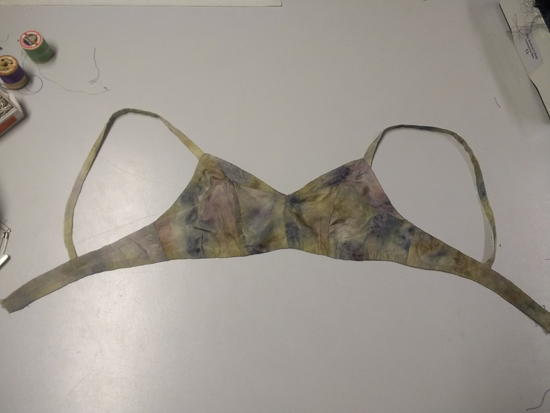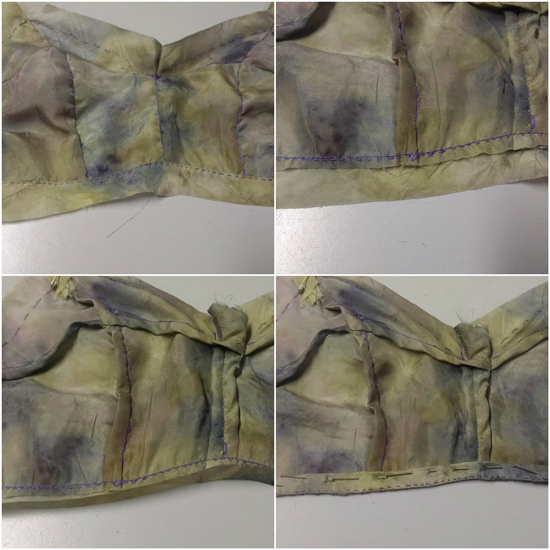Hello all, for this post I'm going to hand you straight over to Zoe!
Hello!
My name is Zoe and I’m one of Lauren’s classmates. I’ve known Lauren for 3 years now as we started our time at Rose Bruford together. Hopefully you’ve all been keeping up with Lauren’s ‘A British Outfit’ series as this is what this post is all about!
 |
| The silver hook and eyes on top were made by Zoe and the bottom hooks and eyes were the reference point |
At the end of our course, as you may know, we are required to do a dissertation style project which can be practical. The variety of things that have been chosen to be researched this year has been fascinating but Lauren’s research area has particularly interested me. It’s a concept that’s never crossed my mind before but has been a fascinating process to watch! As a result I have naturally offered my services for anything she may possibly need.
One of the biggest challenges I’ve seen come up so far has been acquiring things that are now completely made overseas.
One day I walked into our workroom to find Lauren and one of our lecturers slaving away with some pliers and a great deal of frustration over the topic of making hooks and eyes for one of Lauren’s garments. After watching for a while, I and another classmate sat watching quite intently with a burning desire to give it a go.
After around half an hour of sore fingers and mild swearing, I added my attempts to the pile for elimination once everyone had produced their finest work.
 |
| My attempts at making hooks and eyes |
Unsurprisingly, from every angle the pile of our finest work looked incredibly sad. None of us were expert metal workers or mass producing machines.
After having a long hard look at all of the attempts, the final decision was made and my hooks and eyes were the most normal looking.
One of our other colleagues described mine selection as ‘the ugly ones from a regular box’ which was quite bittersweet and very funny.
Anyway, Lauren figured you would love to know how I did it!
One thing to remember before going into this project is that your hooks and eyes won’t be perfect. You aren’t a machine. Each one will be unique but that’s part of the beauty.
This is what you will need!
Wire (British/country of choice). One metre should be enough for practices and then the real deal. Ormiston wire very kindly send me a sample to play with.
Tiny pliers! The main pair of pliers that we used were borrowed from someone who got them from a Christmas cracker.
Hooks and eyes for reference
Second pair of small pliers (optional)
I’ve put a second pair of pliers as optional because at some points when I was trying to even out what I’d made, it was easiest to hold the fastening with one pair and bend with the other.
To make the hooks
Step 1. Make a guide.
To make the hooks and eyes around the size of a standard box, I made the guide around 2cm with a third mark at 2.5cm long. Remember this is a rough guide! The picture below doesn’t have the third guide mark, at the time I just guessed.
Step 2. Holding the wire
Pick up the end of your wire with your pliers. To get the best shape here don’t let the wire pop out the other side of the pliers. If you can start the end of the wire in the middle of the pliers jaws.
Step 3. Making the loops
What you need to do here is curl the wire as tightly as possible around the jaws of the pliers. This will give you a tight loop that you will use to see the hooks and eyes down with.
Once you’ve made the first loop, hover the wire over your guide and cut the wire at the 2.5cm mark. After this repeat step 3 to make the second loop on the other side. Your curled wire should sit roughly within the 2cm guide nicely. Unless it’s quite a lot out this isn’t a big issue if it doesn’t fit.
You may need to tighten the loops you make by using the pliers to push the loops into the long bits of wire
This is what mine looked like after tightening the loops.
Step 4. Creating the point
At this point, it’s time to create the point that will make the hook.
Roughly find the middle of the wire and bend the two ends together creating, what I’ll admit looks like quite a phallic shape. The closer in length the two ends are to each other the better.
Use the pliers to make the point as tight as possible without creating a sharp point. The two loops may start to cross over and if this happens use your fingers to lightly pull them away from each other enough so that they sit close together but don’t overlap.
Step 5. Creating the hook
This is the final step! Find the rough middle of the point you’ve created and bend it towards the loops creating the hook. If the hook is at an obtuse angle, use the pliers on the point end and press to close the gap enough so that it would work as a functioning fastening.
And there you have your own hand made hook!
To make the eyes
Step 1. Cut the wire
Go back to the guide we made for the hooks. Cut a piece of wire to be around 2cm long using the guide.
Step 2. Making the loops
Just like for the hooks, hold the end of the wire in the middle of the pliers jaws. As tightly as possible bend the wire around the pliers creating a loop. Repeat this on the other side of the the wire and then nip the ends of the loops to tighten them up.
Step 3. Making the eye
This bit is the hardest bit. Start by putting the middle of the wire in the jaws of the pliers and lightly bending. Move the wire slightly to one side and lightly bend. Repeat this on both side until you have a gradual curve over the eye. Once you’re able to get the loops into the jaws of the fliers both together this step is complete.
Step 4. Finishing the eye
Once the gradual curve has been made, use the pliers to tighten the bottom by pushing the loops together. They don’t need to be tightened up a large amount, just to your personal preference using the premade eye as a reference.
And there you have your hook and eye!
Good luck with making your own hooks and eyes and hope this was helpful!
 |
| DIY hook and eyes on top and reference hook and eyes below |
Thank you for reading, and huge thanks to Zoe for putting this tutorial together!
Lauren xx


























